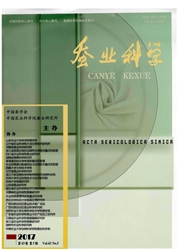

 中文摘要:
中文摘要:
vasa是决定生殖系发育的重要调控蛋白因子之一,具有广泛的保守性。利用家蚕基因组和EST库的数据资源,分析了家蚕vasa基因的结构,并与已有报道的18个物种的VASA蛋白质的结构域序列进行了比对分析,同时对家蚕vasa基因在家蚕胚胎发育11个时期的表达型及幼虫期8个不同组织的表达特异性进行了验证。结果表明,家蚕vasa基因包含有13个外显子,比果蝇vasa基因的外显子数量(7个)增加了6个,在第3内舍子有1个转座子插入;家蚕vasa基因在未受精卵和胚胎发育的各个时期均有表达,但只在幼虫生殖腺中有表达。将家蚕vasa基因的一条cDNA片段用地高辛标记作为探针,对家蚕幼虫的生殖腺及胚胎进行全胚原位杂交,结果进一步表明家蚕vasa基因在幼虫期只在精原细胞、精囊、卵巢管等生殖系相关的细胞和组织中表达,在发育5d胚胎的生殖腺部位也有明显表达。
 英文摘要:
英文摘要:
vasa is one of the key regulatory protein factors of germ plasm in Drosophila. It is conserved across species. The structure of silkworm vasa gene was analyzed by using present silkworm genome and EST data. VASA domain sequences from 18 species were aligned and their phylogenetic relationships were analyzed. Besides, the expression profile of silkworm vasa gene during embryogenesis and in larval tissues was detected. Results showed that there are 13 exons in the silkworm vasa gene, six more than that of Drosophila vasa gene. A transposable element locates in the third intron. Results also showed that silkworm vasa gene is expressed in unfertilized eggs and fertilized eggs of all embryonic stages. Nevertheless, it is only detected in the gonads of fifth instar larva, not other tissues. A silkworm vasa cDNA fragment was cloned and labeled with DIG and used as probes in situ hybridization on silkworm gonads and embryos, Results showed that silkworm vasa gene only expressed in cells and tissues which are related to germ line such as spermatogonium, spermatophore, and ovary tube, et al. There is a strong signal on the dorsal of 5 days embryo where is correspond- ent to the site of future gonad.
 同期刊论文项目
同期刊论文项目
 同项目期刊论文
同项目期刊论文
 期刊信息
期刊信息
